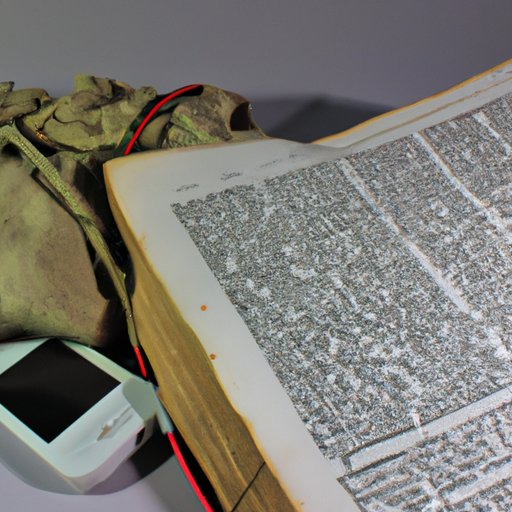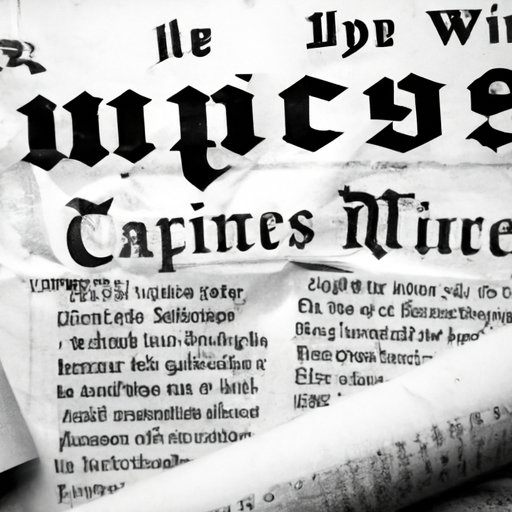Introduction
News has always been important in human societies, and Ancient Rome was no exception. The dissemination of news was essential for the functioning of the Roman Empire and its citizens. In this article, we explore how news traveled in Ancient Rome and the impact it had on Roman society.
Examining Ancient Roman Inscriptions to Uncover the News Network
Inscriptions were an important tool for the dissemination of news in Ancient Rome. According to historian Michael Kulikowski, “Inscriptions were a major source of information about the lives of the non-elite, who rarely appear in other sources.” These inscriptions were typically written on stone or metal tablets and often contained announcements of laws, edicts, or decrees issued by the government. They also included notices of military victories and other events as well as personal messages.
Inscriptions were placed in public areas such as marketplaces, temples, and other places where people gathered. As such, they served as a way to spread news quickly and widely throughout the Roman Empire. They were also used to announce the arrival of foreign dignitaries and the death of prominent citizens.
The Role of the Cursus Publicus in Ancient Roman News Distribution
The cursus publicus (Latin for “public course”) was a system developed by the Romans to facilitate the rapid movement of information and goods across their empire. It was a network of roads, bridges, and postal stations that extended from Britain to Egypt, allowing for the speedy delivery of messages and goods.
The cursus publicus was used to transport official documents and dispatches from one part of the empire to another. It also allowed for the rapid spread of news across the empire, enabling the Romans to stay informed about events happening in faraway lands. This system helped shape the news network in Ancient Rome, allowing for the quick dissemination of news throughout the empire.

Exploring the Use of Physical Messengers for News Sharing in Ancient Rome
Physical messengers played an important role in the distribution of news in Ancient Rome. These messengers, known as nuntii, were typically slaves or freedmen employed by the government to carry official documents and dispatches. They were also used to deliver personal messages between individuals.
The nuntii played an important role in the news network of Ancient Rome. They were responsible for delivering messages and documents quickly and efficiently, ensuring that news was disseminated quickly across the empire. They also served as eyewitnesses, providing firsthand accounts of events that occurred in distant parts of the empire.

How Ancient Roman Newspapers Influenced the Spread of News
Newspapers were an important source of news in Ancient Rome. These newspapers, known as Acta Diurna, were published daily and contained news from around the empire. They reported on events such as military campaigns, political developments, and religious festivals. They also included gossip, scandals, and other stories of interest.
The Acta Diurna shaped the news landscape in Ancient Rome. The newspapers served as a reliable source of information and helped to spread news quickly and widely throughout the empire. They also helped to shape public opinion, as they provided citizens with access to news from all corners of the Roman world.

Investigating the Use of Smoke Signals for News Dissemination in Ancient Rome
Smoke signals were also used to communicate news in Ancient Rome. These signals were used to send messages from one point to another, usually over long distances. They were typically used to communicate military news, such as the arrival of an enemy army or the success of a battle.
Smoke signals were an important part of the news network in Ancient Rome. They allowed for the quick and reliable transmission of news over long distances, ensuring that news was disseminated quickly throughout the empire. This helped to ensure that citizens were kept informed about events occurring in distant parts of the empire.
Conclusion
News was an important part of life in Ancient Rome, and the Romans developed a sophisticated system of news dissemination. Inscriptions, the cursus publicus, physical messengers, newspapers, and smoke signals were all used to spread news quickly and efficiently throughout the empire. This system of news distribution helped to shape the news network in Ancient Rome and had a profound impact on Roman society.
(Note: Is this article not meeting your expectations? Do you have knowledge or insights to share? Unlock new opportunities and expand your reach by joining our authors team. Click Registration to join us and share your expertise with our readers.)
